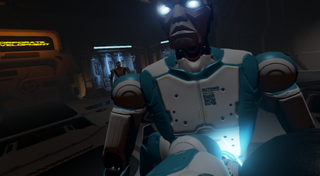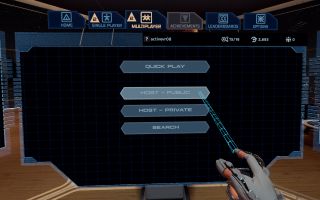'Raw Data' Cross-Platform System Is Clunky, But It Works: Hands On

Survios brought Raw Data to the Oculus Rift platform this week, but it wasn’t just a simple port. The developer rebuilt the game’s mechanics to suit the Rift’s tracking capabilities, and it integrated cross-platform gameplay so Rift players can join forces with Vive players against the evil robots at the Eden Corp. facility. We took it for a spin to see what’s different on the Rift version.
Raw Data is a game that gets you moving—a lot. Survios saw the capabilities of the Lighthouse tracking system and decided to leverage its potential to create the first “active VR” game, and the concept paid off. People flocked to Raw Data when it came out, and it became the first VR game on the Steam platform to exceed $1 million in sales in one month.
By choosing to pursue an active VR experience with Raw Data, Survios limited its potential customer base to Vive owners. At the time the game was released, there was no motion controller system for the Rift, and Oculus led us all to believe that its Constellation tracking system would be limited to standing, 180-degree experiences. Such a configuration doesn’t lend itself well to a highly active experience—especially one that’s built around a 360-degree tracking space.
Oculus changed its tune about tracking spaces when it finally revealed the full details about the Touch controllers at OC3 in October. The company announced that the default configuration would remain a two-camera 180-degree setup, but you would have the option to configure the cameras in an experimental 360-degree position, or you could buy a third camera to support room-scale tracking.
Following the release of Oculus Touch, Survios opted to support Oculus’ VR platform. The developer didn’t want to limit its Oculus audience to the small number of players that picked up a third tracking camera to enable room-scale tracking, so it redesigned the movement system in the game for Oculus users. Vive users must turn around within their play space to see things to the side and behind them, whereas Oculus players get a button to press that spins their view by 90 degress, which makes the game compatible with 180-degree tracking.

The 90-degree instant spin is necessary if your tracking cameras are both in front of you. If you set them up in opposing corners of your room to enable 360-degree tracking, the quick spin is still helpful, because it lets you avoid tangling the Rift’s relatively short tether cable.
I find Survios' button choice puzzling, though. To turn to the left, you press the X button on the left Touch controller. To spin to the right, you press the A button on the right Touch controller. I prefer the method that Vertigo Games used for Arizona Sunshine, which uses the thumbstick to turn to the left or right. Pressing the X and A buttons is arbitrary, but flicking a thumbstick feels natural.
Stay on the Cutting Edge
Join the experts who read Tom's Hardware for the inside track on enthusiast PC tech news — and have for over 25 years. We'll send breaking news and in-depth reviews of CPUs, GPUs, AI, maker hardware and more straight to your inbox.
A Large Player Base
Survios was successful at building a community around Raw Data on the Vive, and the company didn’t want to segregate its newfound fans when it expanded to support the Oculus platform. When the company made the announcement about Raw Data coming to the Rift, James Iliff, Survios’ chief creative officer, revealed that the game would offer cross-platform cooperative gameplay.
“We’re thrilled to welcome the Oculus player community to Raw Data,” said Iliff. “With VR still a young, niche industry, it’s crucial right now for the entire community to be united regardless of platform. We believe VR is ultimately going to be a platform-agnostic medium, and we’re showing our support for that shift with Raw Data’s new, cross-platform compatibility—and that’s just the beginning. We’re going to do everything we can to create content for the entire VR community.”
Raw Data isn’t the first VR game to offer cross-platform gameplay. CCP added cross-platform multiplayer to Eve: Valkyrie when it launched the game on PSVR (and later, on Steam VR). Ubisoft also offers cross-platform gameplay for all of its VR titles, including Werewolves Within, Eagle Flight, and the soon-to-be-released Star Trek: Bridge Crew. We’ve also had the pleasure (amusement?) of testing out Vertigo Game’s implementation of cross-platform co-op in Arizona Sunshine.
Though there are multiple examples of cross-platform VR gaming, standards for implementing such features don’t seem to exist. CCP’s cross-platform gameplay is completely seamless. You could be playing alongside someone using a PSVR and fighting someone with a Vive, and you would never know it. Ubisoft’s cross-platform setup is just as painless as CCP’s; every player, regardless of platform, connects to the same pool for matchmaking. Vertigo Games’ cross-platform system is far less streamlined. If you have a Vive and you want to play with someone who has a Rift, you must set up a direct IP connection between the two players.
Raw Data’s cross-platform system falls somewhere between the hassle-free systems from CCP and Ubisoft and the clunky system that Arizona Sunshine relies on. In Raw Data, everyone is connected to the same pool of players, but you can’t invite players from the opposing platform. If you want to play with a friend with the competing headset, you must create a public match and have them connect to your game. When Rexly Penaflorida II and I tried to play a match together, I had to kick multiple random strangers out of my match before Rexly could connect. I could see Rexly’s avatar standing in the lobby, but his silhouette was nearly invisible, and I could not click on it to invite him to my match.

Believe it or not, that is the official method for playing with a friend with a different headset. Survios wrote an instruction guide and pinned it to the Raw Data Steam community discussion page, which tells you to use the method we described above.
Once Rexly managed to grab the vacant slot in my match, everything about the game worked as it does when two Vive owners are playing together. We could see each other’s avatars and wave at each other, and we even did a virtual high-five after destroying a wave of robots. The voice chat also worked properly (after I fixed a microphone blunder on my end), which allowed us to communicate and coordinate our plan of attack.
There’s Still Time To Get It Right
It’s nice to have cross-platform gameplay, and it’s excellent that it works more or less seamlessly for random strangers looking for a match. But having no easy way to create a private match between friends with different headsets is a problem. If Survios is serious about helping VR become a “platform agnostic medium,” it will need a solution for this problem. For the time being, this should do; some functionality is better than no functionality, after all.
Survios still has plenty of time to perfect its cross-platform system. Raw Data is still in early access, and the developer is actively working on the game (although some of its resources are now focused on Sprint Vector). The latest release is version 0.6, which presumably means Survios has much more work to do before the full game launches. Perhaps by then, the developer will have found a solution for matchmaking between Vive and Rift players.
As it stands, Raw Data is a great game, and with passionate developers working feverishly on the title, it stands to only get better. And now, a wider audience can enjoy it.
Kevin Carbotte is a contributing writer for Tom's Hardware who primarily covers VR and AR hardware. He has been writing for us for more than four years.
Most Popular




